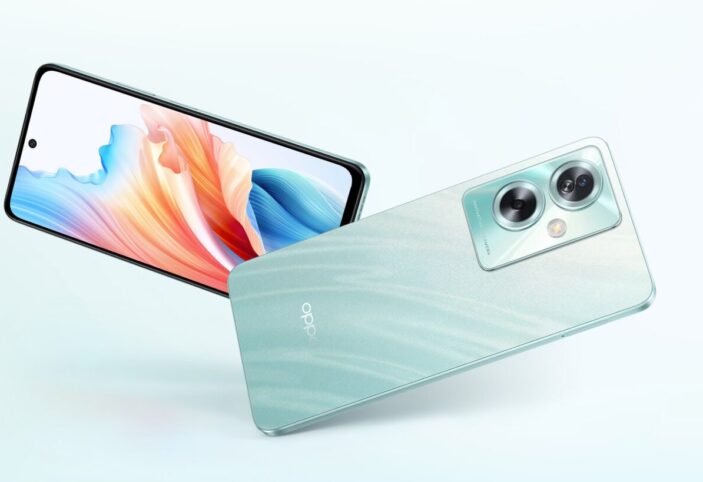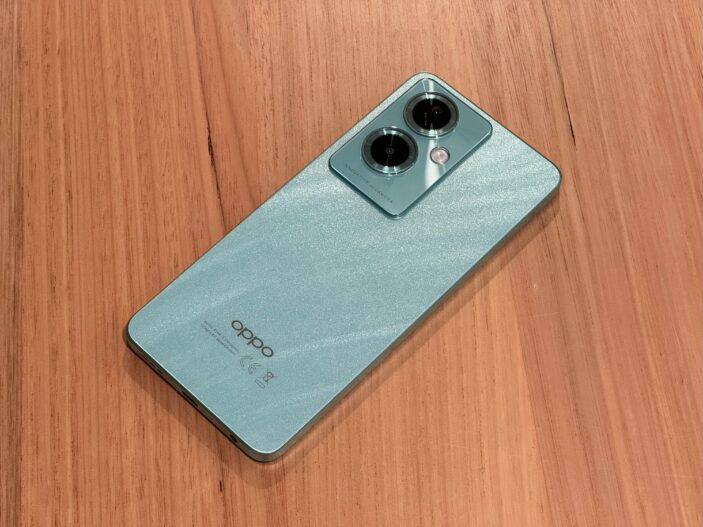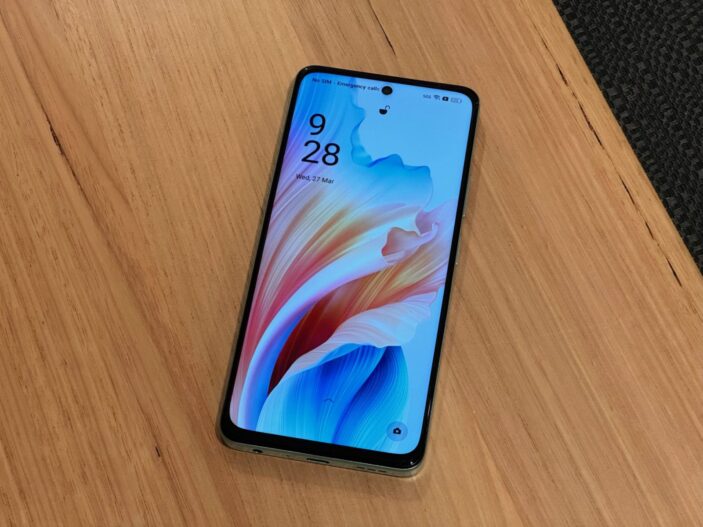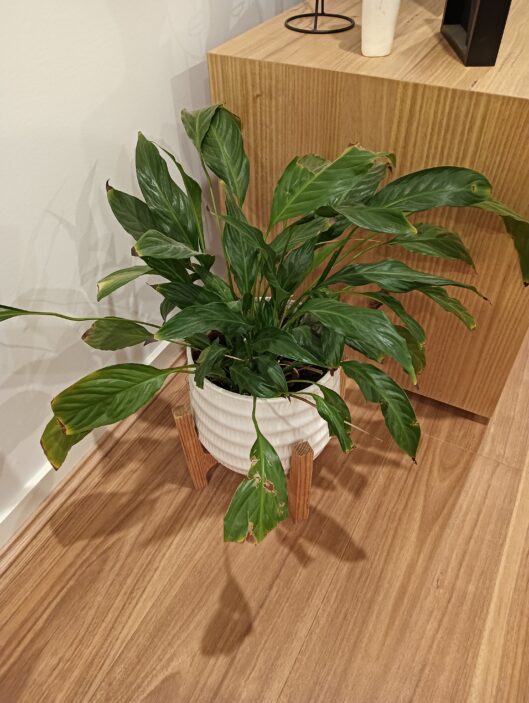
We’ve reviewed a few OPPO phones over the years, and have enjoyed most of them for their sleek design and decent performance. While they’re great value for money, the train seemingly keeps rolling with new solid options on the market each year. Enter the OPPO A79 5G. Its predecessor, the A78 5G, might have been lacking in terms of raw performance but certainly made up for it when it came to screen and build quality.
The A79 5G takes smaller, yet solid steps forward in almost every department. It’s probably worth debating the upgrade from something like an A78 5G for the everyday user, but there’s no doubting the sheer value that OPPO have packed into this A$369 handset.
Design
Unfortunately, the design has seen the least amount of change. Sure, the display is larger, clocking in at 6.72 inches, but it feels very much the same in the hands, due to the squared edges. It’s also a little heavier, weighing it at 193g, a little more than the A78 5G’s 188G. As always, it’s still much lighter than the iPhone 15 Pro Max, clocking in at 221g and supposedly lighter than ever. This makes it a decent option for longer sessions in the hands, even if the squared edges can dig into your pinky if it sits under the phone like mine.

Around the sides, you’ll find the fingerprint-enabled lock button and volume rocker on the right, with the sim and MicroSD card slot to the left. The back has probably seen the most change. While the ‘Innovative AI Camera” slogan returns, it’s tucked nicely under the squared camera module, which stands out from the sandy, glossy look of the rest of its back. Available in Mystery Black and Glowing Green, I must say, the latter shines as the more exciting colour, both figuratively and literally.
Performance
OPPO throws in the Mediatek Dimensity 6020 processor, and it’s certainly decent for everyday use. Much like our A78 5G review, the A79 5G runs about as well as you would expect for an entry-level handset. It’s going to open and close most basic apps rather smoothly, and barely heats up under casual use, even over longer periods.
While this sounds straightforward, it generally depends on the user. Like the A78 5G once again, this isn’t a gaming phone and does struggle with things like Call of Duty Mobile, which has, funnily enough, become a vague benchmark of sorts for most of my phone reviews. It will run, just not well, so consider your usage. Running on the latest ColorOS 13.1 update, it’s also super clean and easy to navigate.
Beyond that, I still feel as though the included 4GB of RAM lets it down in places. It’s mainly an issue when multiple background apps are running, and can change between what’s left open. That being said, I did notice a couple of occasions, although a rarity, when the handset would feel sluggish, only to find I had several background apps left running throughout the day. It’s not a dealbreaker but does lead me to believe we’re slowly seeing the last of 4GB RAM handsets if this is how they’re affecting daily usage.
Its Wi-Fi 5 capabilities are also capped at 433Mbps, which is well and truly enough for most Australian homes and networks, even if the signals aren’t great at times. I will give it the benefit of the doubt though, as signals usually come down to a blend of issues, like router and network quality.
I can also commend the A79 5G for its inclusion of dual speakers, both up top and down low, which helps the soundstage feel more even and balanced. It still lacks bass and can feel a little tinny at times, but the overall volume levels are strong. This also applies to the loudspeaker during calls, which utilises noise-cancelling from the top-end microphone. You can also take advantage of Real Original Sound Technology EQ, which allows you to customise and fine-tune the sound stage.
Finally, the A79 5G packs in a fingerprint-enabled lock button and facial recognition for security, the latter of which works way better than you would expect for a phone of this price, in almost every condition. I’m still wondering just how they do it. Overall, the A79 5G is relatively spot on as an everyday driver for lighter usage, from social media and streaming to browsing and calls.
Display
The FHD+, 2400×1080, 90 Hz, Panda Glass display won’t blow anyone away, but I would be lying if I said it wasn’t decent. 120 Hz displays feel like they’re around the corner in entry-level handsets at this price, but I can appreciate the 90 Hz display for a smoother, more responsive feel, even during regular scrolling and swiping.
It also utilises what OPPO refers to as a Sunlight Display, which can crank up brightness considerably when outside in direct sunlight. It’s a step up from the A78 5G’s 480 nits, with this now belting out up to 680 nits at peak brightness. This won’t feel as noticeable indoors, but it’s nice to know the capabilities are there, as it can also help spruce up everyday content.

Its sRGB and DCI-P3 colour gamut are also decent, meaning the display itself provides some quality streaming with a mix of both natural and vibrant colours. I’m always streaming something on my phone, from background YouTube during gaming to Netflix in bed, and I was admittedly impressed with just how well this LTPS LCD held up. While the black levels could be better in darker environments, it’s also to be expected in cheaper, entry-level handsets, so I won’t drag it down a great deal.
Camera
The 50MP main camera and 2MP secondary camera are decent, but not great. Don’t be fooled by the sheer amount of megapixels on offer here, as the lens and sensor size always win at the end of the day. In brighter, well-lit conditions, there’s not really much to worry about. Images feel vibrant and clean, with little to no noise in the right environment.
An included Night mode helps at times to liven things up in darker conditions but generally does little to hide the fact that it’s not great in low light. That secondary 2MP camera certainly helps with zoom for closer shots but brings with it a little more noise, much like the A78 5G did.


The 8MP front-facing camera does a better job at capturing detail when compared to the A78 5G, even if the AI still gets in the way, making skin tones feel either washed or saturated in the process. It’s not broken, but certainly noticeable in brighter conditions, where everything feels a little off.

You can access the portrait setting once your face is detected to alter the AI input, although I feel its presence even when the settings are toned down. But at the end of the day, it’s still decent enough to whip out for a quick shot in most well-lit conditions.
Battery
The OPPO A79 5G comes with a 5000mAh battery, that feels par for the course, and will get you through most days with ease. The only real gripe here is the lack of a charging adapter. The included USB-A to USC-C cable works with that sweet 33W SUPERVOOC charging brick, but it’s just not included with the phone. While that also feels par for the course, it’s just a shame that for a similar price last year, the A78 5G came with one included.
Either way, expect to round out the day with 20-30% left in the tank, with fast charging getting this back up to maximum capacity within the hour, provided you’re happy to fork out another A$35 for that admittedly sweet 33W SUPERVOOC charging brick.
Verdict & Value
OPPO may have taken smaller steps to bolster the A79 5G this time around, but it’s hard to complain about it too much when all those steps are in the right direction. The screen is brighter, the processor is faster and more efficient, and the camera is as solid as it has ever been in an entry-level handset at this price.
While it’s tricky to recommend it as an upgrade to the A78 5G in particular, there’s no doubt this would make a solid upgrade for those looking to renew their everyday driver for basic needs, if their handset is at least a few years old.
![]()
![]()
![]()
![]()
![]()
FOUR STARS (OUT OF FIVE)
Highlights: Smooth 90Hz display; Solid 50MP main camera; Sleek and sturdy design
Lowlights: The 2MP main camera is still lacking; Multiple background apps can cause stuttering; No included 33W SUPERVOOC charging adapter
Manufacturer: OPPO
Price: A$369
Available: Now
Review based on unit supplied by OPPO.
